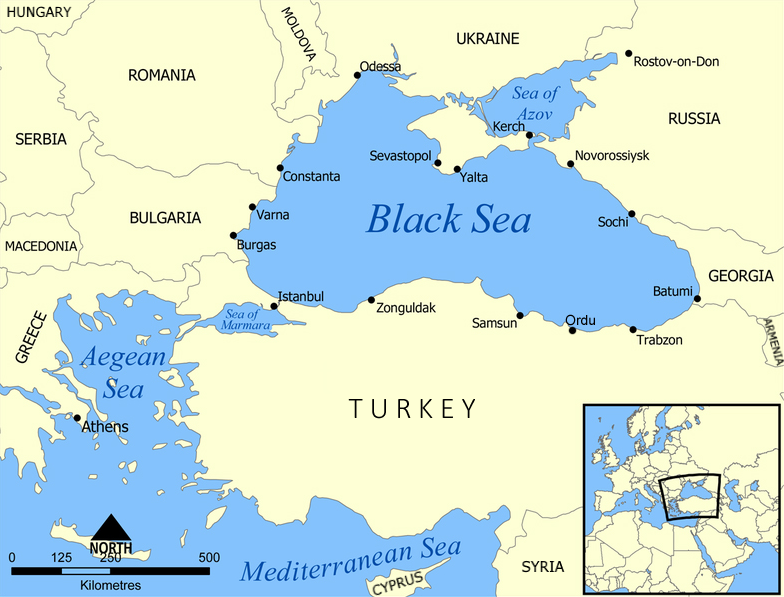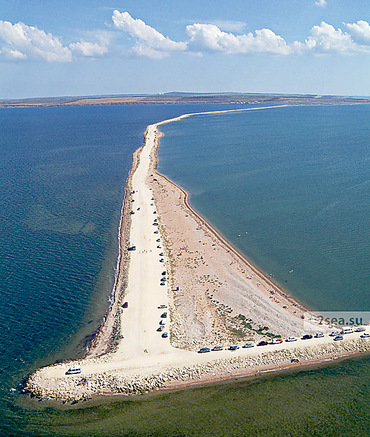Did You Know?
- Nearly 90% of the 700-mile-long, up to one-and-a-half-mile-deep Black Sea is considered a zero-oxygen “dead zone”—containing more poisonous hydrogen sulfide than any other water body in the world.
- Three layers of water exist in the Black Sea: (1) The top layer of oxygen-rich surface waters supporting life in the sea constitute only about 13% of the Black Sea volume. (2) Below that is a very thin layer where the top and bottom layers mix; and (3) The bottom layer—found at a depth greater than 150 -200 meters—consists of a permanent hydrogen sulphide zone devoid of life. Oxygen is completely absent at this level.
- The Bosphorus Straits has two currents flowing in the opposite direction! (1) The upper flow leaves the Black Sea and carries cooler and less saline surface water out of it. (2) The bottom flow carries heavier salt water from the Mediterranean to the Black Sea.
- Black Sea tide is almost imperceptible. It reaches scarcely 10 cm in height.
Black Sea Water Layers
The Black Sea is connected to the Mediterranean through the narrow and winding Bosphorus Straits. This complex natural system makes the replenishment of seawater in the Black Sea very slow. Every year the Black Sea receives more fresh water from rivers flowing into the Black Sea than it loses from evaporation. Due to this, the surface waters are less salty hence less dense and “float on the top”.The slow replenishment and the bad mixing of waters does not provide enough oxygen for the normal process of marine decomposition and the bacteria in the lower layers use it up entirely. Consequently the Black Sea is virtually dead below a depth of about 180 meters. Moreover the metabolism of some bacteria generates hydrogen sulphide, a soluble poisonous gas associated with the smell of rotten eggs. A dangerous level of hydrogen sulphide is present in the entire lower layer of seawater in the Black Sea.
|
Why is it called the Black Sea?
The name may have been derived from the color of the water at great depth or from the sea's storminess. In ancient times, heavy storms and the lack of islands made sea dark and dangerous for seafarers. Another possible explanation is due to the color of the Black Sea's deep waters. At the lower level, the unique microbial population which produces black sediments and visibility is on average approximately five meters (5.5 yd), as compared to up to thirty-five meters (38 yd) in the Mediterranean.The World's "Sixth-Largest River"
The opposing currents of the Bosphorus as described above has been rechristened as the world's "Sixth-Largest River”. In 2010, a British team from Leeds University used a robotic submarine to scan the seabed near Turkey. This undersea river, up to 115 feet deep in places, carries a volume of water 10 times greater than Europe's biggest river, the Rhine. Traveling at a brisk 4 mph, this underwater river creates flood plains and is carving out channels much like a river on the land,.| Color-augmented 3-D Radar Images |
Asteroid Danger?
There have been isolated reports of flares on the Black Sea occurring during thunderstorms, possibly caused by lighting igniting combustible gas seeping up from the lake depths.Modeling shows the release of the hydrogen sulphide clouds in the event of an asteroid impact into the Black Sea would pose a threat to health—or even life—for people living on the Black Sea coast.
Photos
Yalta Castle
Crimean Coast
Crimean Mountains
Danube River Delta
Kerch Strait
Additional Maps
 |
| Relief Map |
| Satellite View |
 |
| Watershed and Major Rivers |
Further Info
Black Sea Overview >(Geography, Oceanography, Ecology, History)
The Black Sea - A Unique body of water >
Wikipedia - Black Sea >
Encyclopedia of Ukraine - Black Sea >
Black Sea NGO network - Commitment to the Black Sea >
Wikipedia - Bosphorus >
Wikipedia - Black Sea undersea river >






No comments:
Post a Comment